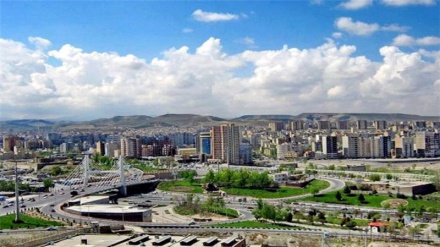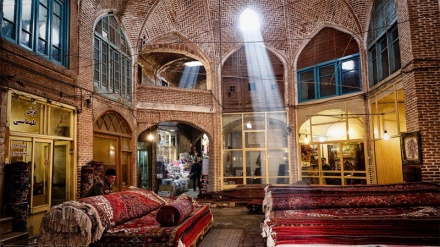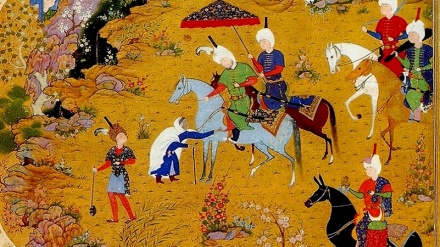Tabriz, 2018 (16)
Welcome to this week's episode of the series "Tabriz, 2018". Today, we become familiar with the two famous museums of the city of Tabriz, namely "Quran va Ketabat" and Moharam Museums.
Among the numerous museums of Tabriz, the "Quran va Ketabat" Museum maintains an especial status. This museum has been established at the venue of Saaheb ul-Amr Mosque.
The said mosque is located east of Saaheb-Abad Square, at the heart of the city of Tabriz, on the banks of Mehran Roud River. This historical mosque has two tall minarets, in addition to two marble arcs, with a marble inscription installed next to one of these arcs. On the top of the other arc, a Surah of Holy Quran has been written by the famed calligrapher of the Safavid era, Alaa Ed-Din. The mosque was destroyed by the troops of the Ottoman Emperor, Sultan Murad the 4th, in 1045 AH.
Upon the retreat of Ottoman troops throughout the rule of the Safavid King, Shah Sultan Hussein, the said mosque was reconstructed and renovated by the vizier of Azarbaijan, Mirza Mohammad Ibrahim. The earthquake which rocked Tabriz in the year 1193 AH, demolished this huge building.
In the year 1266 AH, the translator of the Russian Consulate, Mirza Ali Akbar Khan, constructed the current courtyard and school within this venue, which were initially named Akbarieh School, while later renamed as Saaheb ul-Amr Courtyard.
This historical monument was named as "Quran va Ketabat" Museum, following its repair, in the year 2001.
Valuable copies of Holy Quran, belonging to different historical phases are kept, and are on display in this museum. Some of these copies of Holy Quran have been written by the Infallible Imams of the Prophet of Islam's Household (Peace be upon them) and other prominent figures, capturing the attention of visitors to this museum. One of the most attractive remains of these volumes, is a page of a volume of Holy Quran, remaining from the 3rd Century AH, which has been written by the 8th Infallible Imam of Prophet Mohammad's Household, Imam Reza (AS) in Kufi alphabet.
Overall, 190 copies of Holy Quran are on display in this museum. One of them is a very small volume of Holy Quran which has been delicately decorated, manifesting the unique skills of Tabrizi artists. This volume of Holy Quran is six centimeters in length and 4 centimeters in width. In the past, artists decorated the covers of volumes of Holy Quran with unique delicacy. This copy of Holy Quran which dates back to 1293 AH is no exception to this rule.
There are also other works of calligraphy on display in this museum which have been created by famed calligraphers such as Ali Reza Abbasi, and Mohammad Hussein Tabrizi. Furthermore, two works of the skilled and prominent author of 14th Century AH, Ali Naqi Shirazi, are on display at "Quran va Ketabat" Museum.
In addition to volumes of Holy Quran and works of famous calligraphers, a number of other valuable objects are kept in the museum. For instance, a bowl made of brass, belonging to 1110 AH, covered with several ayahs of Holy Quran is kept in this museum.
Moharam Museum is situated in one of the historical and cultural houses of the city of Tabriz, which belonged to Abul-Qasem Sehati. Following his demise, and based on his will, this historical and cultural house was handed over to the Cultural Heritage, Handicrafts, and Tourism General Department of East Azarbaijan Province.
It is a three-story building, covering an area of 409 square meters. Its architectural style belongs to the waning years of the Qajarid era. This building was enlisted among Iran's historical monuments in the year 2008.
The mourners of the Third Infallible Imam of Prophet of Islam's Household, Imam Hussein (AS) and his 72 steadfast companions, who courted martyrdom in Karbala in the epic of Ashura, are hosted at the basement of this museum throughout the first 12 days of the holy month of Moharam. This basement is also used to convene other ceremonies of the holy month of Moharam such as recitation of the ayahs of Holy Quran and deliverance of religious speeches. In the different sections of this museum, a number of ceremonies of the holy month of Moharam in different regions of East Azarbaijan Province are also portrayed.
Among the East Azarbaijan Province's mourning ceremonies on the anniversary of the epic of Ashura, nine of the them have been registered as the country's national heritages.
As of its foundation to this date, everyone can visit Moharam Museum, free of charge. Within the holy month of Moharam, this museum hosts visitors, and mourners of Imam Hussein (AS) as of 8 a.m. to 3 p.m.
MR/ME


